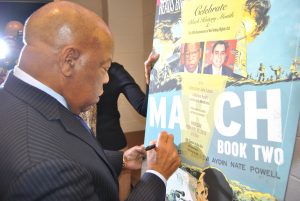When I was a student, I didn’t like history. All of those dates and times didn’t seem applicable to my life. I preferred reading actual stories about what happened to people. As I grew older and learned that history is much more than timelines, I really enjoyed exploring the different ways that stories can be told. And seeing these stories told in comic books adds another dimension. I’ve put together a short list of graphic novels that explore Black history and culture. Hopefully they'll inspire other reluctant historians, or provide a different perspective to help you learn something new.
It’s one thing to read about the civil rights movement as a disconnected observer. It’s another to read a first-hand account. John Lewis was an American hero, and his three-book series March describes his part in the fight for equality. The story still feels urgent, ranging from Lewis’ birth and childhood in Pike County, Ala., to the inauguration of President Barack Obama in 2009. And the art, sparse but emotional, is a wonderful counterpoint. The same artist, Nate Powell, drew the art for The Silence of Our Friends, another graphic novel with a personal account of the civil rights movement. (Read more about U.S. Rep. Lewis and his incredible life with our recommendations for adults, teens and kids.)
The concept of African Americans "passing" as white people has been frequently used in literature. Graphic novels are no exception. Incognegro by Mat Johnson is a fictionalized account of the exploits of Walter White, an executive secretary of the NAACP during the 1930s. He used his fair skin as a shield against the racism of the South to investigate lynchings. Johnson’s creation, Zane Pinchback, balances his fear of being caught with his drive to know and report the truth. It’s a thrilling and tense story that reads like a taut mystery. Johnson published a sequel, Incognegro: Renaissance, 10 years after the first novel.
Bttm Fdrs by Ezra Claytan Daniels is a comic about gentrification in Chicago. It's also a body horror comic that discusses how we create art and what it means to return to your roots. Although Bttm Fdrs is not based on an actual event, the cycle of artists moving into under-resourced neighborhoods and displacing the original residents still takes place in cities around the country. What happens when the neighborhood decides to fight back?
These books just scratch the surface of this exciting genre. For more titles, visit our list of recent Black History and Culture Graphic Novels.




Add a comment to: In Living Color: African American Historical Graphic Novels